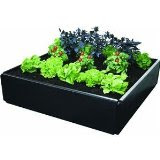A raised bed garden is a garden that is above ground and contained in an area with high sides. The gardener walks between the beds and it is a very organized way to garden. Herbs grown in raised beds have an advantage over in the ground growing for a few reasons.
How to Make a Raised Bed Garden
The most popular raised bed is the 'contained raised garden bed'. They offer great growing condition for many vegetable and herb gardens, as well as for flower gardens. Also, many fruits such as strawberries, grapes and raspberries do well in raised garden beds.
Since most raised beds are constructed from wood we have created steps for a wooden raised bed.
Step One
Selecting a site is one of the most important decisions you will make when creating a raised bed garden. If you want to plant vegetables that need partial sun either create another bed in a different location or find a location that will receive both full and partial sun. If you want to make watering easy try installing a drip irrigation system that will be easy to use and keep your garden perfectly watered.
Step Two
Decide the size and shape of your garden. Make sure you will be able to access all part of your garden without stepping into the bed. Try keeping the garden long and narrow which will allow you to access all your vegetables without actually stepping on the garden. Remember accessibility is key and if you decide to put your garden up against a fence try making it only 3 feet wide so you don't have to step on the garden. The depth of the raised bed garden is up to you but the deeper the better, especially if you will be growing carrots or parsnips that need deeper soil. If you can try making your bed 12 inches deep!
Step Three
Once you have the shape and size of your garden you will begin building the bed. It's a good idea to dig out the existing sod and loosen the soil below to a depth of eight to twelve inches. This will give your garden extra depth and good drainage. If you want to move fast just cover the existing sod and soil with newspaper or cardboard.
Step Four
Now it's time to construct the bed. Depending on the size of the garden by 'two by six' pieces of wood that will be able to build the entire garden.
Step Five
After constructing the frame in a location you desire make sure to level your bed from all directions. If part of your frame is high, just remove some of the soil beneath it until you have a level frame.
Step Six
After leveling it is time to fill your garden with soil and compost. This will allow you to create a garden with great soil that is ideal for the vegetables you choose to grow. Once they're filled and raked level, you're ready to plant or sow seeds.
Maintaining a Raised Bed Garden
Happily, raised bed gardens require very little maintenance. Each spring or fall, it's a good idea to top dress with fresh compost and manure, or, if your bed only holds plants for part of the year, go ahead and dig the compost or manure into the top several inches of soil. As with any garden, mulching the top of the soil will help retain moisture and keep weeds down. Moisture retention is important, because raised beds tend to drain faster than conventional beds.
Here's Garden Bed Selections :
Greenes Raised Garden Bed 4'x6'x9"
Buy New $89.00
Suncast RBD939 48-Inch Panel Tiered Resin Raised Garden Kit
Buy New $86.88
The Emsco Group 2350 Raised Garden Bed
Buy New $39.46
Frame-It-All Small Animal Barrier Stainless Steel Expandable Garden Fence
Buy New $60.97
Just Add Lumber Vegetable Garden Kit - 8'x8' Deluxe
Buy New $149.00





